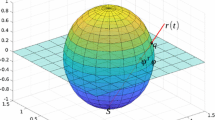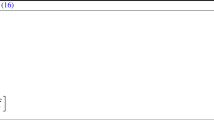Abstract
This paper investigates the properties of digital hyperplanes of arbitrary dimension. We extend previous results that have been obtained for digital straight lines and digital planes, namely, Hung's evenness, Rosenfeld's chord, and Kim's chordal triangle property. To characterize digital hyperplanes we introduce the notion of digital flatness. We make a distinction between flatness and local flatness. The main tool we use is Helly's First Theorem, a classical result on convex sets, by means of which precise and verifiable conditions are given for the flatness of digital point sets. The main result is the proof of the equivalence of local flatness, evenness, and the chord property for certain infinite digital point sets in spaces of arbitrary dimension.
Similar content being viewed by others
References
C. Ronse, “A bibliography on digital and computational convexity (1961–1988),”IEEE Trans. Patt. Anal. Mach. Intell., vol. 11, 1989, pp. 181–190.
S.H.Y. Hung, “On the straightness of digital arcs,”IEEE Trans. Patt. Anal. Mach. Intell., vol. 7, 1985, pp. 203–215.
A. Rosenfeld, “Digital straight line segments,”IEEE Trans. Comput., vol. 23, 1974, pp. 1264–1269.
C. Ronse, “A simple proof of Rosenfeld's characterization of digital straight line segments,”Patt. Recog. Lett., vol. 3, 1985, pp. 323–326.
C. Ronse, “Criteria for approximation of linear and affine functions,”Arch. Math., vol. 46, 1986, pp. 371–384.
C. Ronse, “A note on the approximation of linear and affine functions: the case of bounded slope,”Arch. Math., vol. 54, 1990, pp. 601–609.
C.E. Kim, “Three-dimensional digital planes,”IEEE Trans. Patt. Anal. Mach. Intell., vol. 6, 1984, pp. 639–645.
I. Stojmenović and R. Tošić, “Digitization schemes and the recognition of digital straight lines, hyperplanes, and flats in arbitrary dimensions,” inVision Geometry, Contemporary Mathematics Series Vol. 119, R.A. Melter, A. Rosenfeld, and P. Bhattacharya, eds., American Mathematical Society, Providence, RI, 1991, pp. 197–212.
J. Stoer and C. Witzgall,Convexity and Optimization in Finite Dimensions I. Springer, Berlin, 1970.
G.H. Hardy and E.M. Wright,An Introduction to the Theory of Numbers. Clarendon, Oxford, 1979.
P.J. Kelly and M.L. Weiss,Geometry and Convexity: A Study in Mathematical Methods. Wiley, New York, 1979.
P. Veelaert, “Digital planarity of rectangular surface segments,”IEEE Trans. Patt. Anal. Mach. Intell., to appear.
Author information
Authors and Affiliations
Rights and permissions
About this article
Cite this article
Veelaert, P. On the flatness of digital hyperplanes. J Math Imaging Vis 3, 205–221 (1993). https://doi.org/10.1007/BF01250530
Issue Date:
DOI: https://doi.org/10.1007/BF01250530




